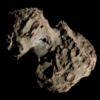astro.wikisort.org - Comet
48P/Johnson is a periodic comet in the Solar System.
| Discovery | |
|---|---|
| Discovered by | Ernest Leonard Johnson |
| Discovery date | August 25, 1949 |
| Alternative designations | 1949 II; 1956 V; 1963 IV; 1970 IV; 1977 I; 1983 XVIII; 1990 XXIII |
| Orbital characteristics A | |
| Epoch | March 6, 2006 |
| Aphelion | 4.983 AU |
| Perihelion | 2.309 AU |
| Semi-major axis | 3.646 AU |
| Eccentricity | 0.3667 |
| Orbital period | 6.963 a |
| Inclination | 13.6589° |
| Last perihelion | 2018-Aug-12[1] September 29, 2011[2][3] October 11, 2004 |
| Next perihelion | 2025-Mar-02[4] |
The comet nucleus is estimated to be 5.7 kilometers in diameter by Lamy, Fernandez, and Weaver.[5] David C. Jewitt and Scott S. Sheppard estimate the nucleus to have dimensions of 6.0 x 4.4 km.[6]
Discovery
E. L. Johnson (Johannesburg, South Africa) discovered this comet with the 25-cm Franklin-Adams Star Camera on 1949 August 24 while making follow-up observations of the new minor planet 1949 OG. He determined the magnitude as 13.8 and described the comet as very small, diffuse, and without a central condensation. He confirmed the comet on August 25.80 and then found prediscovery images on plates exposed on August 15.81 and August 20.82.
Historical Highlights
- The comet was already passed its closest approach to Earth when discovered, having passed 1.26 AU away on August 3. Subsequently, the comet's brightness was virtually unchanged during the coming weeks as it headed for its September 16 perihelion passage. Johnson remained the most prolific observer of this comet. He reported a magnitude of 14.5 on October 16 and upon making the final observation of the comet on November 19.8 he estimated the magnitude as 15.5.
- The comet was first identified as periodic during 1949 September, after less than a month's observations had been obtained. W. P. Hirst was the first to publish such an orbit, which indicated an orbital period of 7.01 years. During mid-month Nevin Sherman (Student's Observatory, Berkeley, California, USA) had computed a very similar orbit with an orbital period of 7.01 years. Sherman said his orbit indicated a possible close approach to Jupiter in 1932. Revised orbits followed during the next few months and it was eventually learned that the orbital period was 6.86 years. Latter investigations revealed the comet was moving in a very stable orbit and that no moderate approach to Jupiter had occurred since 1706 (0.42 AU).
- During 1955, W. H. Julian and B. O. Wheel worked out the details of this comet's upcoming apparition and predicted it would arrive at perihelion on 1956 July 24.22. They commented that the comet would be "well placed for observation in the Southern Hemisphere during all except the beginning of the year." Jacobus Albertus Bruwer (Union Observatory Annexe, Hartbeespoort, South Africa) recovered the comet with the 25-cm Franklin-Adams Star Camera on 1956 August 6.94. He estimated the magnitude as 13.5. The position indicated the prediction by Julian and Wheel needed corrected by +2.4 days.
- The comet has been seen at every return since its discovery. The perihelion distance of 2.2 to 2.3 AU prevents it from coming closer to 1.2 to 1.3 AU from our planet. Subsequently, the comet never becomes especially brighter and usually experiences a relatively slow brightening and fading as it approaches perihelion. Following the discovery apparition, the comet experienced another very favorable return in 1956 and attained a maximum magnitude of 13 around the time it passed closest to Earth (1.28 AU) on August 22. Conditions were less favorable in 1963 and the comet's maximum reported magnitude was 17, with the closest approach to Earth being 1.38 AU on September 11. Still more unfavorable conditions existed during the 1970 return with the closest approach to Earth being 1.65 AU on October 8. The maximum reported magnitude was only 18.8.
References
- MPC
- Seiichi Yoshida (2008-10-12). "48P/Johnson". Seiichi Yoshida's Comet Catalog. Retrieved 2010-03-01.
- Syuichi Nakano (2008-05-06). "48P/Johnson (NK 1610)". OAA Computing and Minor Planet Sections. Retrieved 2010-03-01.
- "Horizons Batch for 48P/Johnson (90000566) on 2025-Mar-02" (Perihelion occurs when rdot flips from negative to positive). JPL Horizons. Retrieved 2022-06-27. (JPL#68 Soln.date: 2021-Mar-19)
- "JPL Small-Body Database Browser: 48P/Johnson" (2005-11-10 last obs). Jet Propulsion Laboratory. Retrieved 2010-03-01.
- David C. Jewitt & Scott S. Sheppard (2004). "The nucleus of comet 48P/Johnson". The Astronomical Journal. 127 (3): 1784–1790. Bibcode:2004AJ....127.1784J. doi:10.1086/382097.
External links
- Orbital simulation from JPL (Java) / Horizons Ephemeris
- 48P at Kronk's Cometography
- 48P/Johnson – Seiichi Yoshida @ aerith.net
- Lightcurve (Artyom Novichonok)
На других языках
- [en] 48P/Johnson
[ru] 48P/Джонсона
Комета Джонсона (48P/Johnson) — короткопериодическая комета из семейства Юпитера, которая была открыта 15 августа 1949 года южноафриканским астрономом Эрнестом Джонсоном в обсерватории Йоханнесбурга с помощью 25-сантиметрового астрографа. Она была описана как небольшой диффузный объект 13,8 m звёздной величины без центральной конденсации. Позднее она была обнаружена и на гораздо более ранних снимках, сделанных 15 августа 1881 года и 20 августа 1882 года. Комета обладает довольно коротким периодом обращения вокруг Солнца — чуть более 6,9 года.Текст в блоке "Читать" взят с сайта "Википедия" и доступен по лицензии Creative Commons Attribution-ShareAlike; в отдельных случаях могут действовать дополнительные условия.
Другой контент может иметь иную лицензию. Перед использованием материалов сайта WikiSort.org внимательно изучите правила лицензирования конкретных элементов наполнения сайта.
Другой контент может иметь иную лицензию. Перед использованием материалов сайта WikiSort.org внимательно изучите правила лицензирования конкретных элементов наполнения сайта.
2019-2025
WikiSort.org - проект по пересортировке и дополнению контента Википедии
WikiSort.org - проект по пересортировке и дополнению контента Википедии

